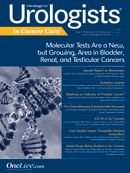Publication
Article
Game Changers in Prostate Cancer
Author(s):
Over the past 6 months, we have had two studies that will profoundly affect our management of advanced prostate cancer patients.
Raoul S. Concepcion, MD
Editor-in-Chief of
Urologists in Cancer Care
Director of Clinical Research Urologic Surgeon Urology Associates, PC Nashville, TN
Over the past 6 months, we have had two studies that will profoundly affect our management of advanced prostate cancer patients.
At the AUA and ASCO, Antonarakis and colleagues from Johns Hopkins presented findings on the identification of an androgen receptor splice variant (SV), AR-V7, on circulating tumor cells (CTCs) in patients with castration-resistant prostate cancer (CRPC) previously treated with abiraterone acetate or enzalutamide. Using quantitative RT-PCR in a small subset of patients (31 in each group), they showed that 39% and 19% of patients treated with enzalutamide and abiraterone, respectively, had detectable levels of the variant, and that those patients had significantly worse clinical characteristics (overall survival, PSA response, radiographic progression-free survival) compared to the AR-V7-negative patient. Their work has since been published (NEJM. 2014;371:1028-1038).
Also at ASCO, results of the 6-year CHAARTED study were presented (J Clin Oncol. 2014;32:5s[suppl;abstr LBA2]). In this study, 790 men with hormone therapy-naïve metastatic prostate cancer were randomized to receive either androgen deprivation therapy (ADT) plus six cycles of docetaxel chemotherapy or ADT alone. Two-thirds of the men had high-volume disease, defined as visceral metastasis and/or greater than four sites of bone metastasis with one outside the axial skeleton. Seventy-five percent had received no prior therapies. There was a 13.6-month survival benefit in men who received both ADT and chemotherapy versus ADT alone. When looking at just the high-volume metastatic patients, the median OS benefit was 17 months. The time to clinical progression and CRPC was also greater in the ADT-plus-chemotherapy group.
I believe it is vital for the urology community to understand not only the results of these two trials, but also the nuances of the patients being treated and the clinical implications. In the last issue of Urologists in Cancer Care, my good friend and colleague, Neal Shore, MD, along with Karen Ventii, PhD, and Dave Crawford, MD, penned a nice summary of predictive and prognostic biomarkers in prostate cancer. Response to treatment is probably the most difficult, yet possibly the most important, information to predict, especially in CRPC patients. We are fortunate to have so many new therapies available, but as we all know, which to sequence or combine is the biggest question. The heterogeneity of these tumors and the multiple resistance mechanisms make this a very daunting challenge. The identification of the AR-V7 SV is at least a start, although there are still many questions and hurdles. The first is validation and the ability to reliably, and predictably, measure the variant, by whatever method.
The CHAARTED data represents, perhaps, an even more significant trial for the urology community, given that we are the providers that often are instituting hormonal therapy and ADT. It is important to understand that the patients in this trial did NOT have biochemical recurrences after definitive therapy, where much of ADT is administered in community practice.
These were hormone therapy-naïve patients who presented with metastatic disease radiographically. As we know, these patients are often asymptomatic. Many also believe that the United States Preventive Services Task Force’s “D” recommendation for PSA screening may result in more men presenting with undiagnosed metastatic disease, akin to the situation in the 1970s and ’80s. There are still many questions about the data in this trial. Twenty-five percent of participants had undergone definitive therapy. What is the time frame of presentation for those patients? What types of therapy did they receive, and what were their initial stages and Gleason scores? A more in-depth analysis of these patients and their clinical characteristics is underway.
Nonetheless, how will this impact the way we manage our patients? Will we be more aggressive, especially in the highvolume metastatic patient, to offer/refer to the medical oncologist to start chemotherapy along with ADT? Will it force us to change our current business model/philosophy in order to better take care of our patients? For the most part, we have been loathe to give neoadjuvant chemotherapy for muscle invasive bladder cancer, despite the published literature. Will this be the same scenario? Downstream, how will this new study, along with biomolecular markers, be incorporated into guidelines for the CRPC patient, given earlier exposure, now, to chemotherapy?
These are thought-provoking data and questions that we will all need to ponder, especially as we move into the world of disease management.










